Archive
2022
KubaParis
Mechanical Bath


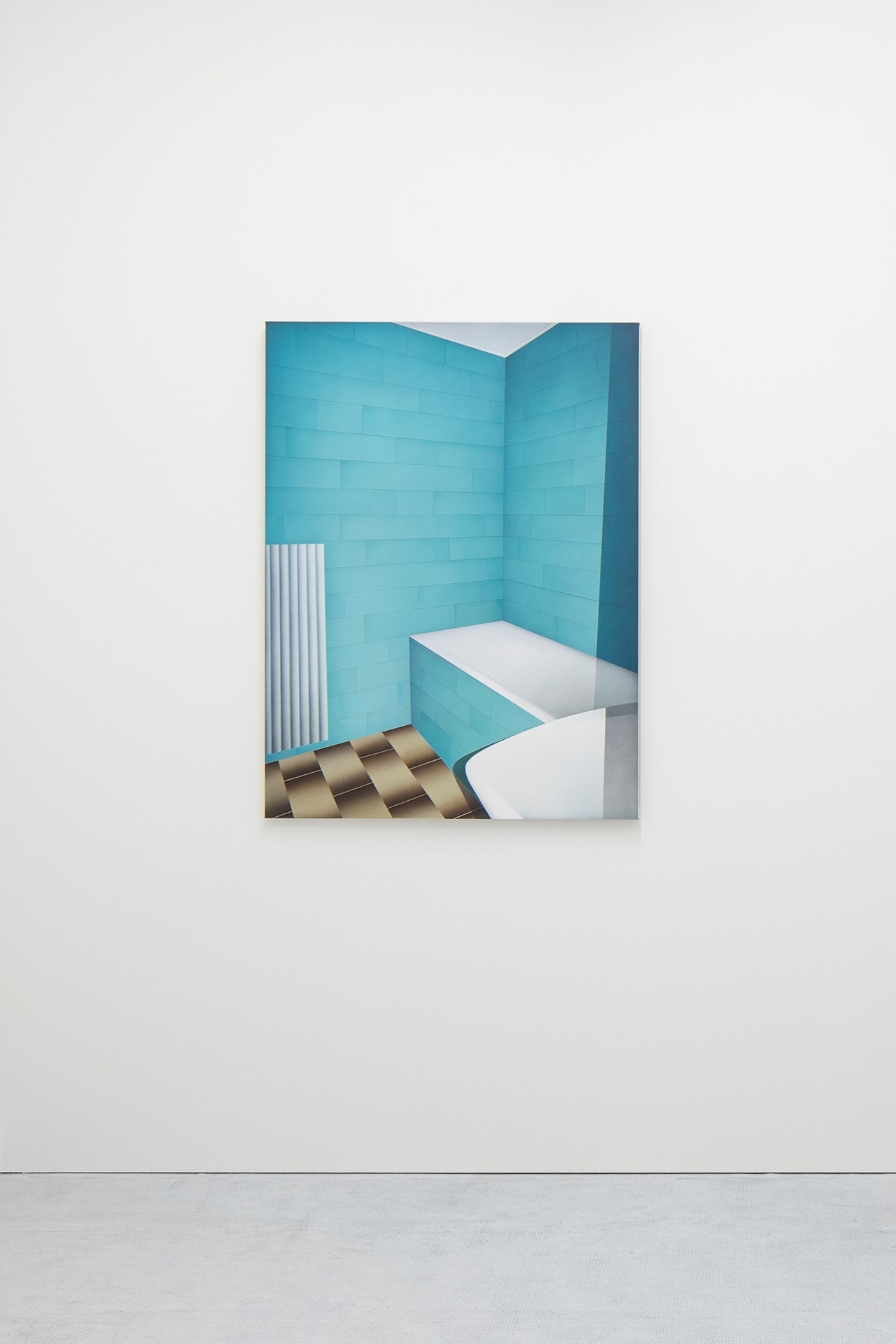
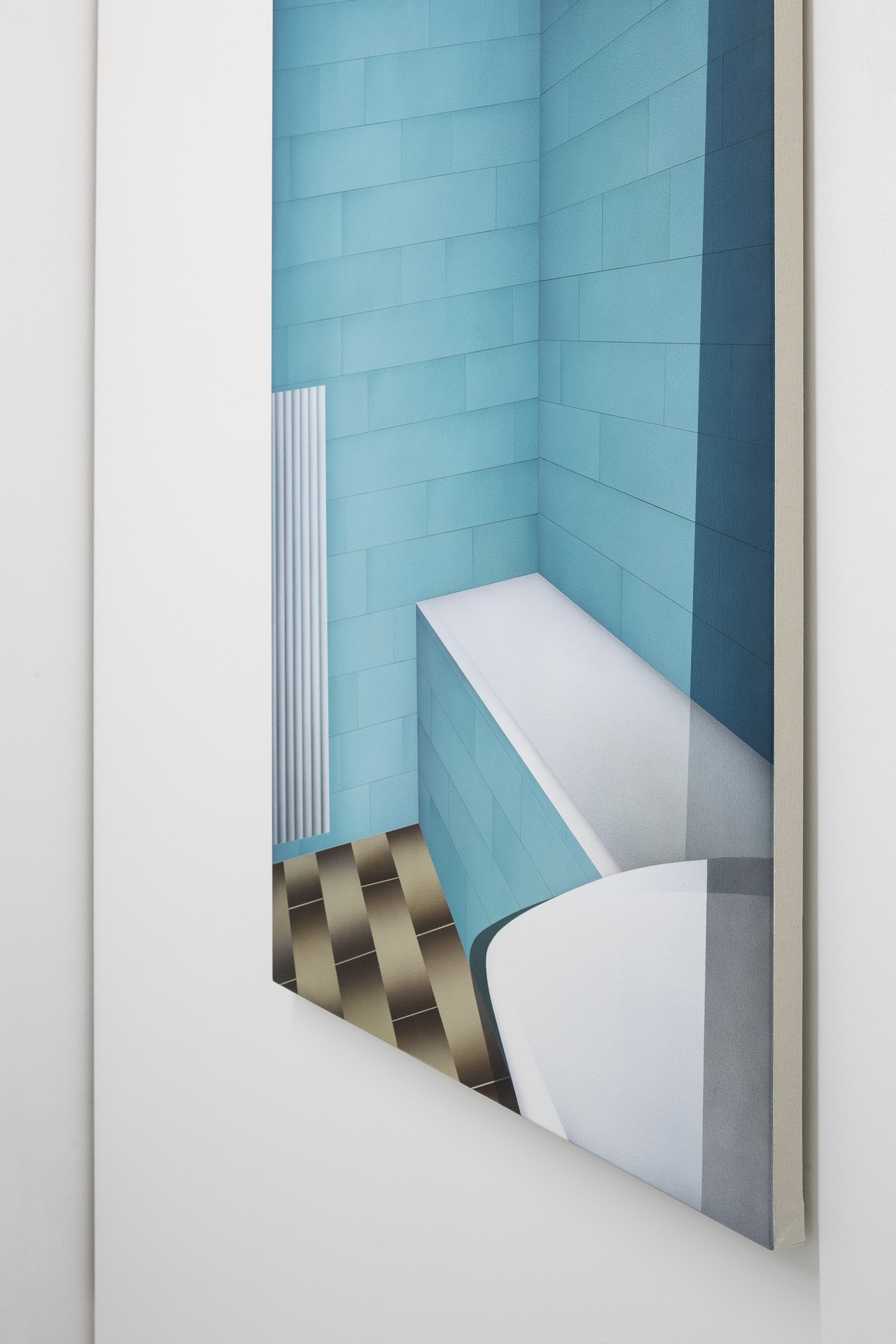
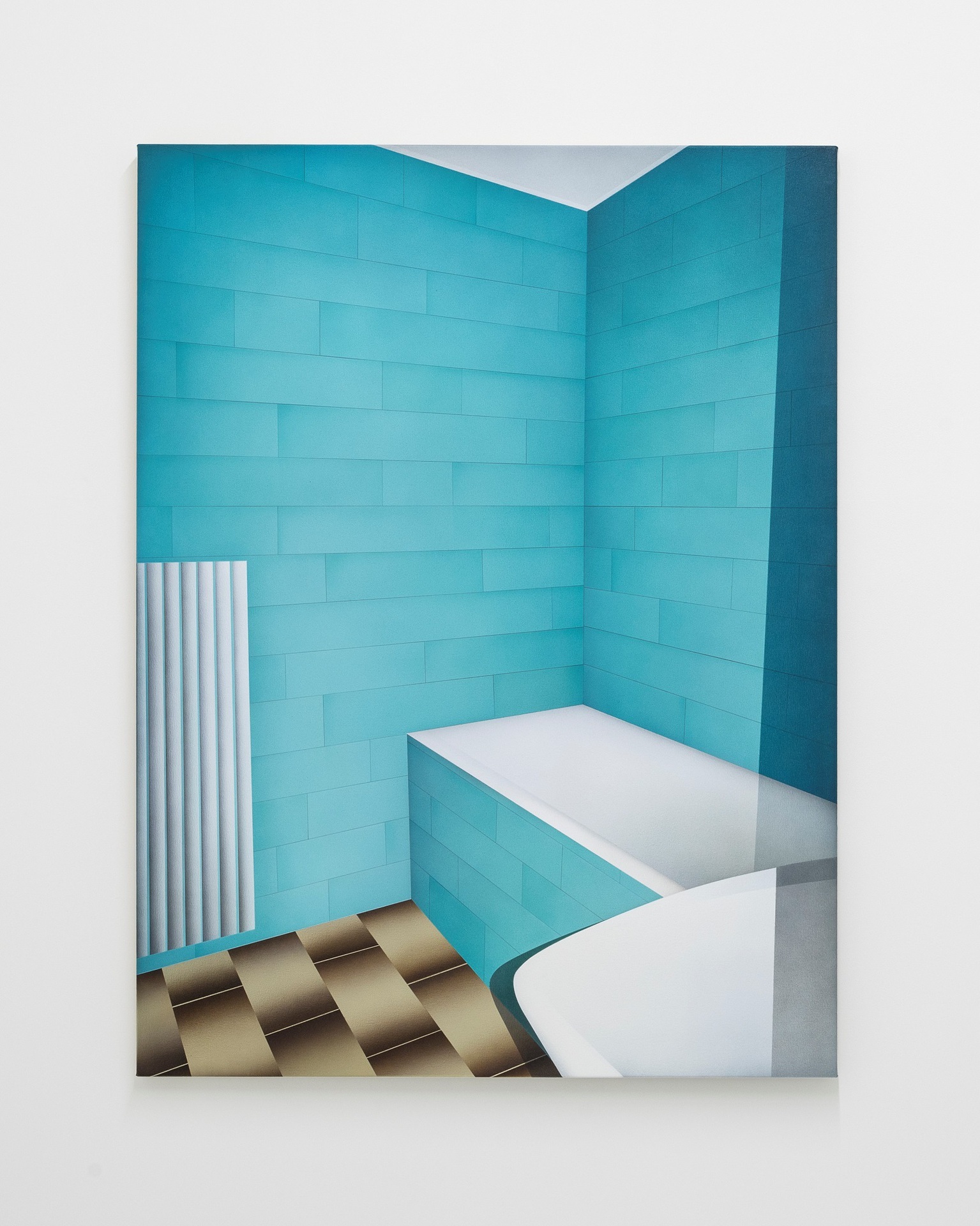
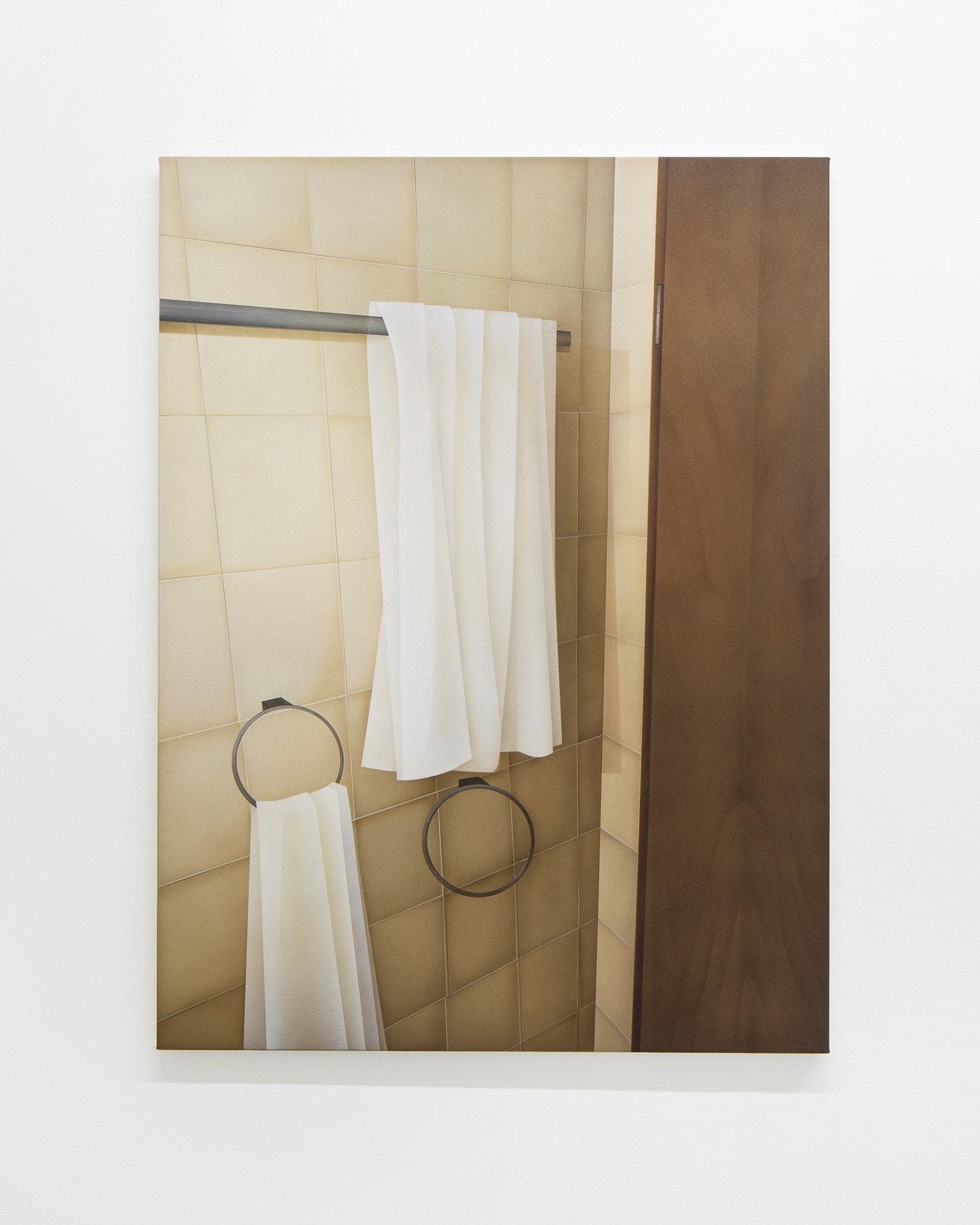
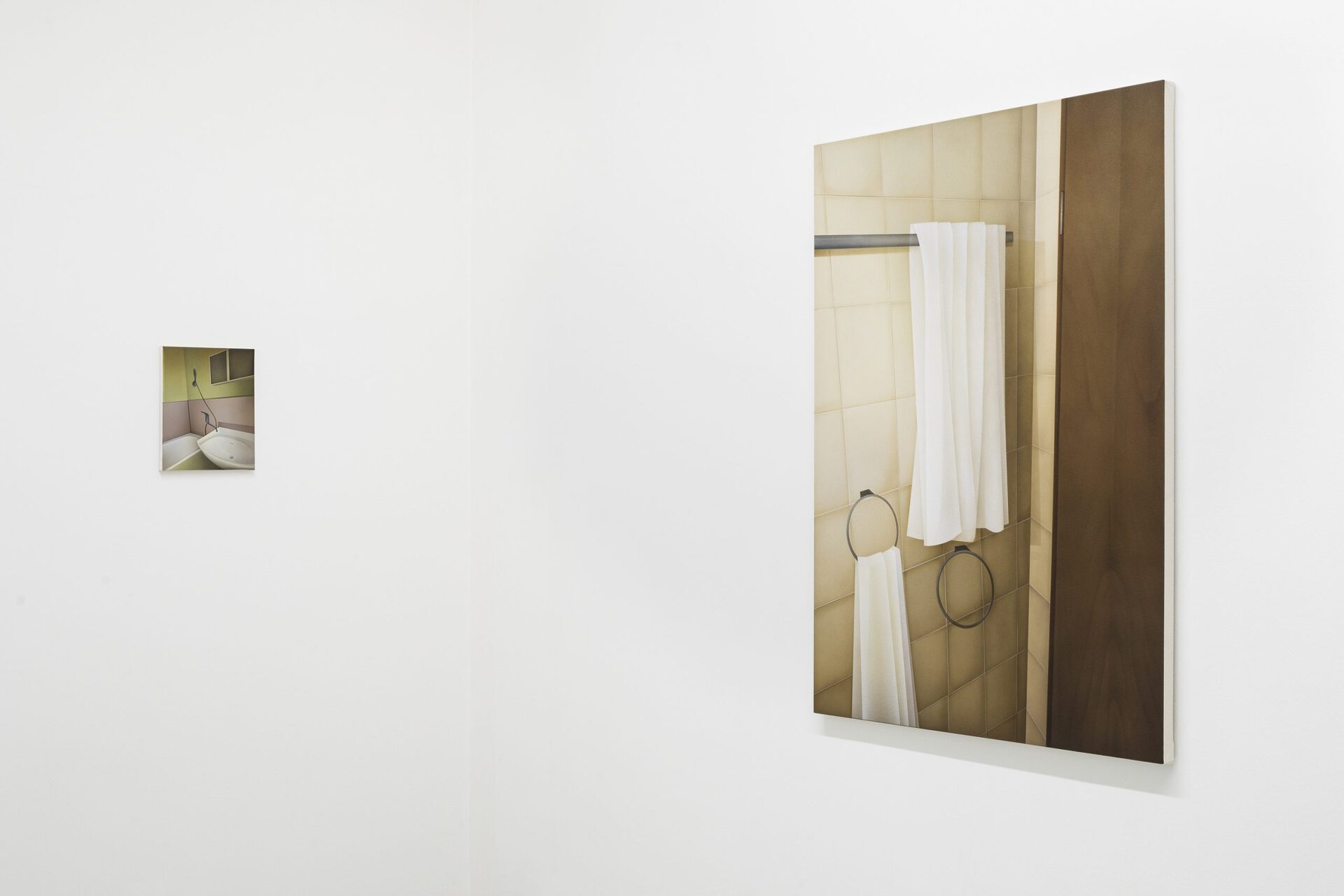
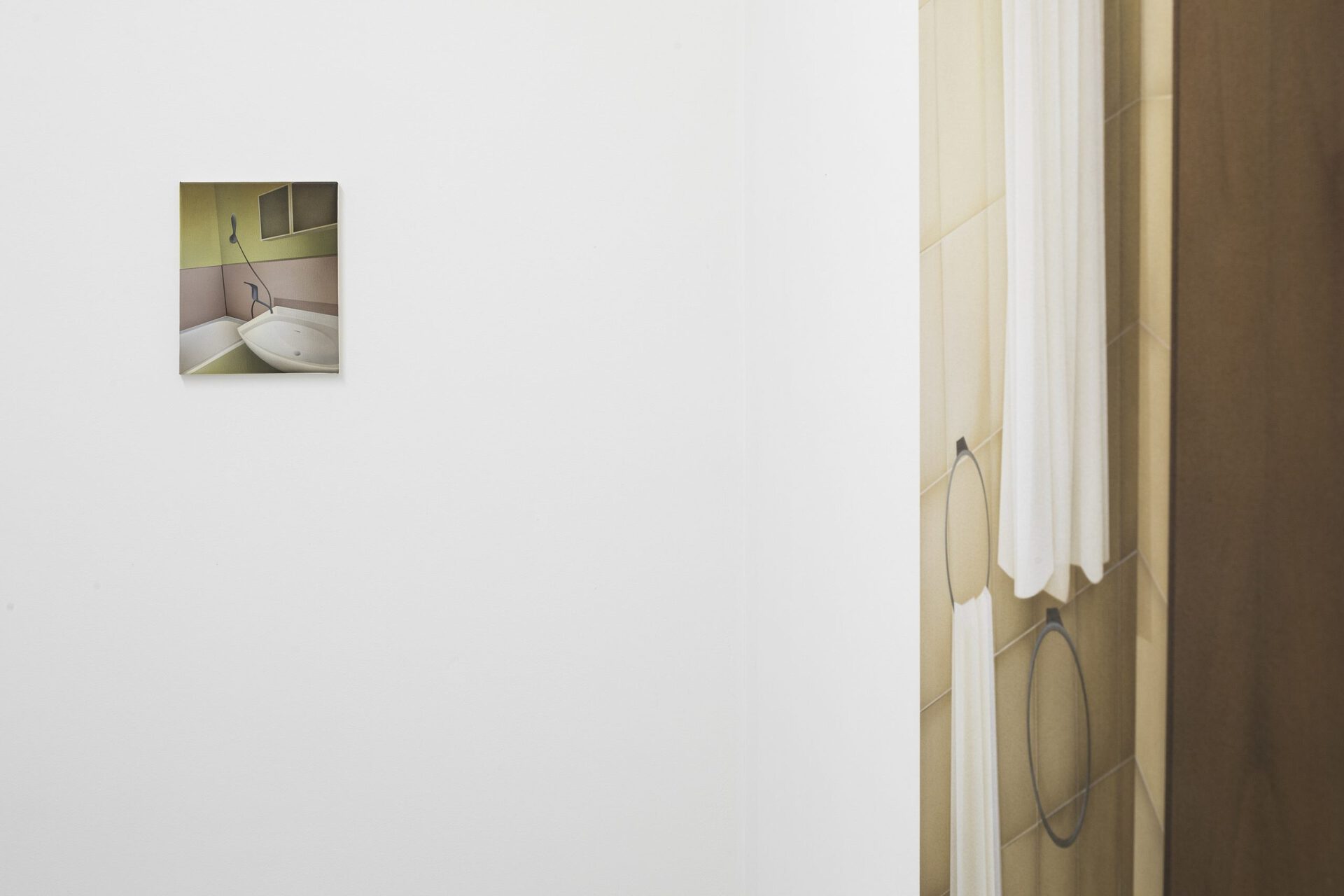
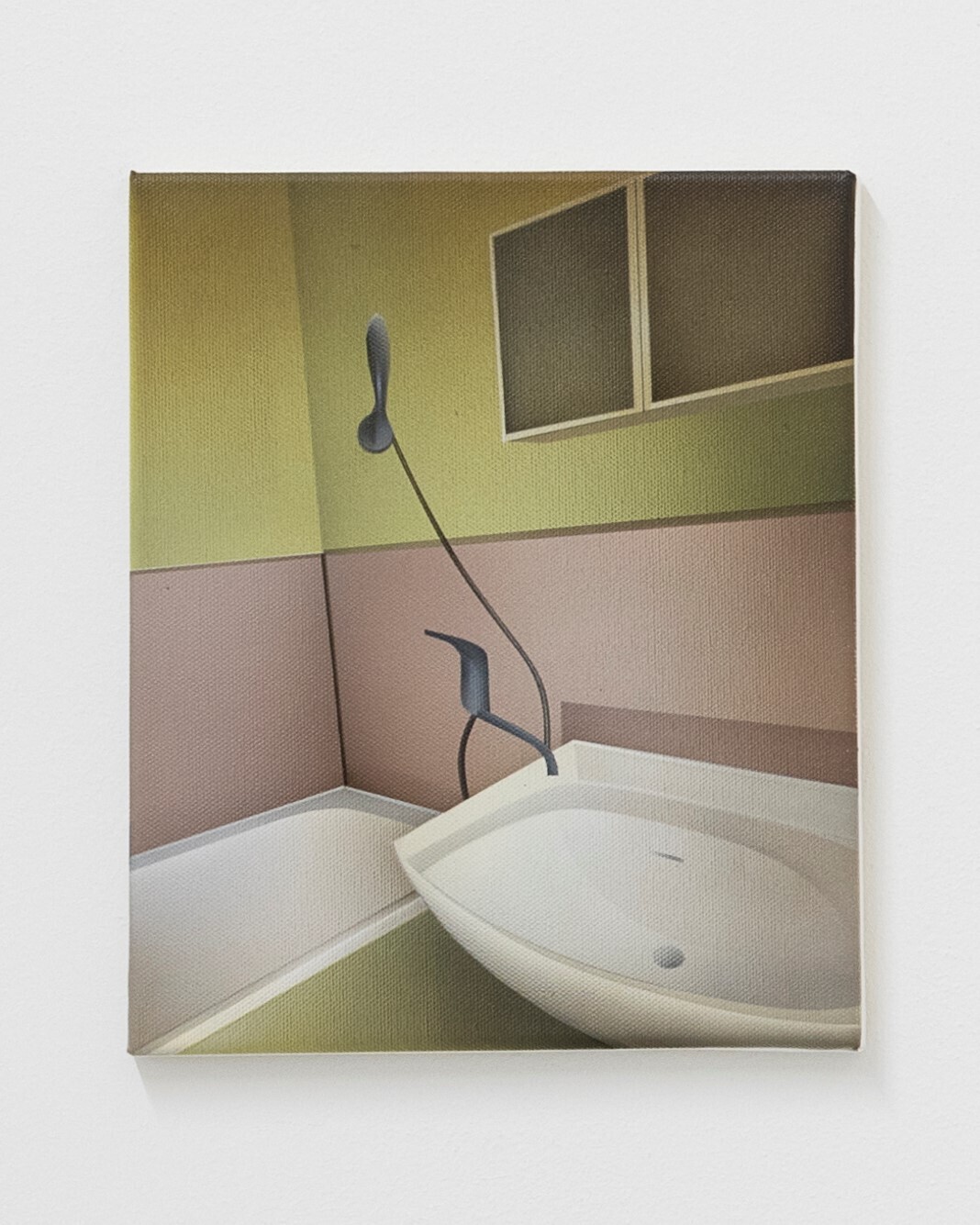
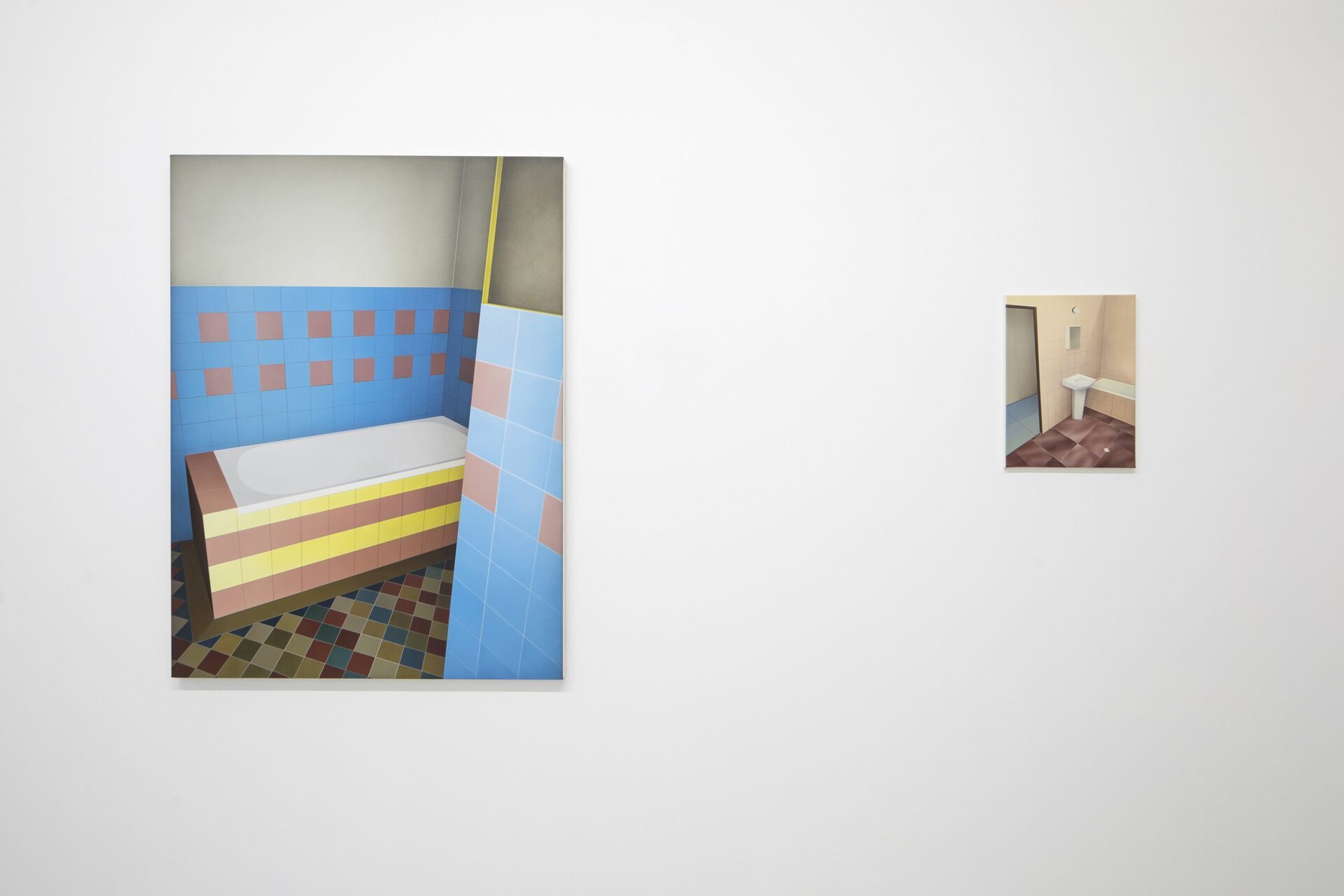
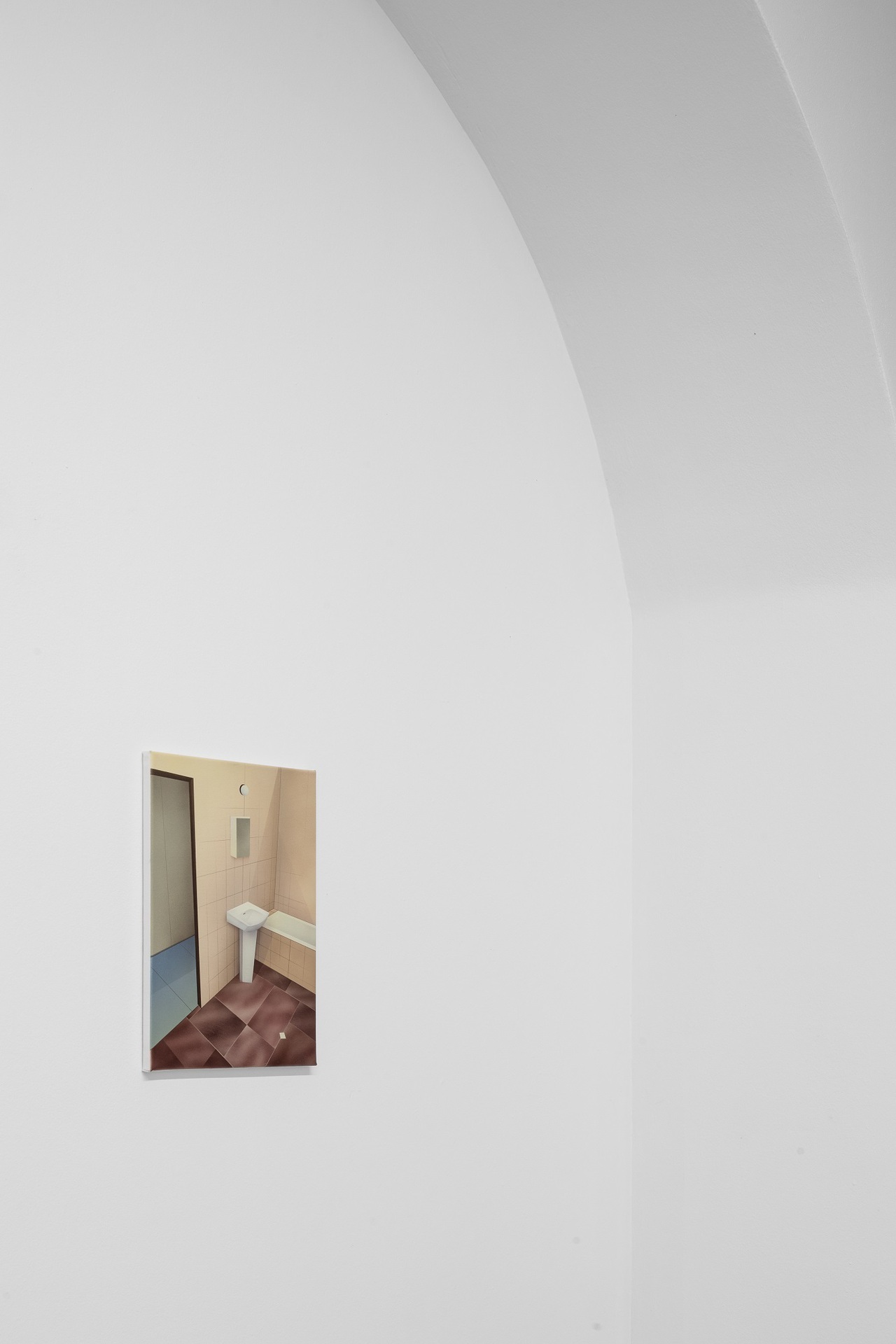


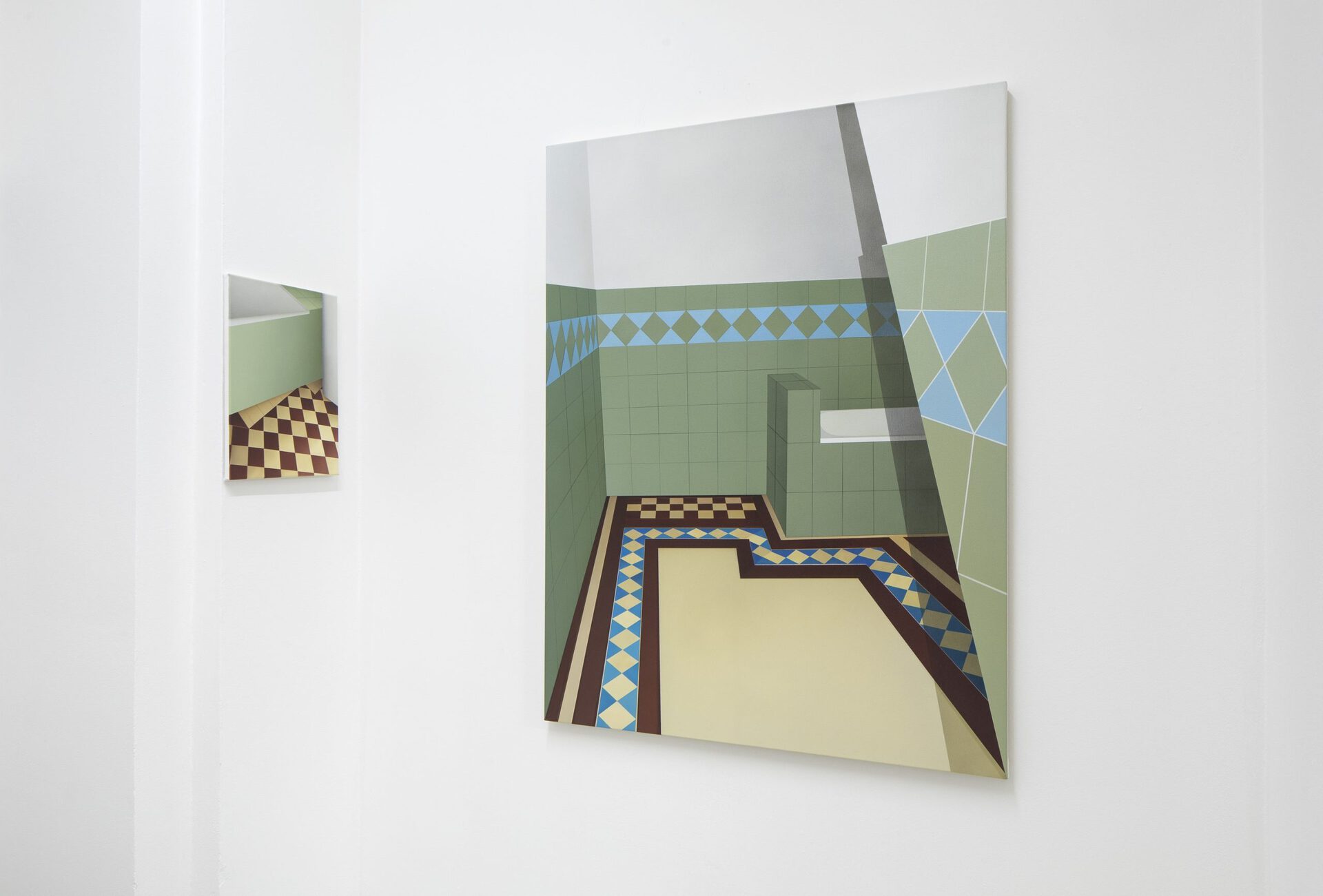
Location
stone projectsDate
08.02 –28.03.2022Curator
Matus NovosadPhotography
Tomas SoucekSubheadline
Alexandra Barth: Mechanical Bath at stone projects, Prague. Text by Matus NovosadText
Alexandra Barth born in 1989, studied at the Academy of Fine Arts in Bratislava (2013-2016). She is interested in the aesthetic aspect of the human endeavor, in the systematic arrangement of space – the private architecture of utility objects. The use of airbrushing makes it possible to work with the impression of „photographic reality“. Lives and works in Bratislava and Verona.
Let’s take a look at Čepan’s review of Milan Laluha. I’ll use his text ‘On the verge of reality and myth’ (Laluha’s Painting Formula)1. The reasons stand in mutual contradiction: the employment of irrational defiance inspires rationality with defiance already inherent in it. Aside from other meanings, defiance in this sense means an opposition to local non-affinity of tastes.
Is Čepan exalting Laluha? Can intellect counterbalance taste and vice versa? Is it regrettable that the taste that enables Alexandra on one hand, disparages Laluha on the other? One is enabled by disparaging the other, an open arena where artists disparage and denigrate each other.
Alexandra Barth was born shortly before Čepan wrote the critique (1990). Afterwards, one of them finds himself in the twilight of his art journey, the other has only two more years to live and the third, Alexandra, is being born to a space Laluha calls home, the ambience of which is heavy with doom and gloom. In the case of Alexandra, I’ve already written about koinobita2 or the character of the painting by virtue of which or via which “it’s possible to live” and thus “live through it”. Koinobita comes in various forms, but what’s certain is that Laluha’s paintings (for contemporary urbanites of Alexandra’s generation?) give off the impression that “it’s not possible to live and thus live through it” with these artworks; perhaps it’s just that together with Galandovci he’s not presenting a sufficiently appealing lifestyle? It’s strikingly disconcerting when the feeling of inability to endure seeps into the artwork of the painter, whose oeuvre is linked to the “expression of Slovakness” or the local quality, and we’re looking the other way.
Galandovci stood in a circle, holding themselves by shoulders and looking at paintings from behind the curtain: a ghettoisation and isolation. Július Koller, their coeval, made a “living symptom” of himself in contrast, mirroring the structure around himself in contrast to Galandovci, whose paintings are reflecting themselves. Central- and Eastern-European isolation doesn’t apply only to the drafting of forms and incomprehensibility but rather our “unwillingness to look” stemming from what Cepan, leaving in a Škoda car, attributes at the end of his text to gossip (OČ); the state of being disgusted. The willingness to look, or its lack thereof, originate from the closeness of artwork, the syntheticism of painting, which informs the “duration of gaze”, but not because of the „lustrousness” present in Alexandra’s and Milan’s works. The duration of gaze still carries great weight when it comes to paintings (perhaps even more so in the age in which attention has become a luxury).
It’s not clear what kind of vitalistic fantasy in terms of the duration of gaze at the curtain will be offered by the artwork of Alexandra Barth. Something along the lines of “the interesting fate” of Tamara de Lempicka? Perhaps. Galandovci found themselves on the spectrum delineated by limits of the “dictate of pseudo-realism” (OČ) and the “allure of the world” (OČ). In my opinion, pseudo-realism is represented by the period production of Ján Mudroch, hence of the preceding generation, and the allure of the world reflects the new possibilities of art in the 1960s. The contradiction was addressed via absolute banality, which, it seems, is not the same as the “surmounting” of the contradiction.
Oskar Čepan links exoticism with homeland in Laluha’s art. However, “our exoticism” (OČ) is connected all the way to Ukrainians and Romanians, hence paintings “the names of which go unmentioned in discourse” but make good market sellers. Here, let’s note for a while the character of contemporary paintings. They’re dull, I call them βdull, beta paintings. They fall into two categories. The first one contains plenty of paintings that are completed, successful, cool. It wishes to be neither synthetic nor bad; it treats transcendental limits as production possibilities and chooses features that are valuable by definition today. The second category consists of artwork that exists in great quantity, but doesn’t attract enough attention as it inadvertently utilizes undervalued features and the name of the artist escapes any mention. It has been lagging behind everything that has ever come up and the origins of its forms and artists remain turbid; it’s also subject to change and quite perceptive. Paintings from the marketplace are structurally analogous to “paintings on the internet”. In the artistic world with a plethora of rooms, most are filled with beta paintings.
We’ve explored two “types” of the paintings and a certain weakness that might factor in the value of the artwork. Čepan also recognizes that type in Laluha’s works, a formula, which in my view makes the paintings appear less than expensive, in comparison to Laluha’s paintings that are the most interesting in his oeuvre – the ones where he employs a different approach. That’s what gives rise to heterogeneity in the oeuvre that translates into autonomous standing of individual pieces of work; let the extraordinary be erased in any way possible. This takes place in hallucinatory (OČ) drawings much more often than in his paintings. If these paintings don’t belong among the “Slovacity type”, then what are they and to which type of region do they belong?
The form is linked to the original basis and simplicity (OČ), complexity might not usher in any significant changes, also because Alexandra is a tree not just a replant (OČ) but she inherently originates from two places. And “the country is not a built country anymore, but rather an archetype of a country” (OČ) and can also be turned around: how does an archetype make it into a country? It’s being built within a developed area.
In Alexandra’s paintings of bathrooms, displayed at Stone Projects in Prague (January 2022), we can observe the heterogeneity of their styles, the contradiction, hence the erasure of provocative vitalistic fantasies. This heterogeneity doesn’t apply to artistic voice but subject: „A painter’s creed is an everyday guarantee of tradition, to dive in, into still life of the world free of fateful controversies” (OČ). The lack of distinguishability in bathroom styles, tied to the value of features, is not rare in Alexandra’s works, but it is most noteworthy in these displayed paintings. In terms of structural analogies, it can serve as Laluha’s version of simultaneous contrast: “A painter’s aim is to artistically specify a double aspect – i.e. a simultaneous contrast in the coexistence of contradictory facts, phenomena and relations, which are bound one way or the other to putting everything he or she trusts in jeopardy.” (OČ)
For the social stratum Alexandra originates from, the contradiction between styles is the cause of one of the types of koinobita, “it’s possible to live here” or, to put it simply, domesticity. It’s as if the uncertainty made the forms collect dirt, even plenty of dirt. Just as Laluha (who was painting while seated almost on the floor) seems to be the opposite to Alexandra, so it’s also worthwhile to discuss what’s (for Alexandra’s type of paintings) a dirty or dirtied painting. Also tied to an acceptable amount of dirt is Laluha’s “…he’s divesting her of typical tragic ending. He’s replacing it with a sort of uncertain unfinished state. With such a modified endgame, rearing its head is a moment of self-preservation of society that the painter has joined his own fate with.” (OČ)
The unfinished state becomes a circle, not in relation to death, but the absence of unconsciousness, from a ballad to an endless choice of an “appropriate door handle”. Of paramount importance is the choice between “small” and “small (βpainting)”.
If we don’t choose what to consume, how can we be part of society and thus produce? “He’s a subject himself of metaphysical anxiety and of his own rationally-justified certainties” (OČ), in Alexandra’s case in the form: “metaphysical anxiety inspired by possibilities” and a “certainty of visual pleasures” (boring consumers are good only to a certain extent).
Unending selection means temporization (Heidegger’s treatment of death), loading of a cart without shopping, a version of Laluha’s approach with a formula “to stabilize everything unstable” (OČ). Just as he “monumentalizes the outgoing tradition” (OČ), with her stylistic ambiguity about bathrooms Alexandra „monumentalizes (consumer identity-wise, the) possibility (of choice)”.
Laluha’s “archaist innovator” (OČ) emerges in structurally analogous way also in Alexandra’s work as a reversibility of painting via the painting’s subject in the form of the young grown old or particularly the old appearing young. “Good quality” (as a rate of pleasure) and the old get separated and become independent of each other. This is caused also by those belonging to an aged generation, whose taste fuels demand for making remakes of the certain “old” – what’s old changes in every age. An old painting in superb quality displays the uncertainty of index relationship to its pre-painting, a photograph in this case that, as Alexandra’s painting shows, is already faking its non-problematic rendering of reality. A photograph was usually perceived from the picture’s point of view and not the fact that (not only) once it’s made its indexicality completely disappears. With remakes or the improvement in the quality of resolution (which will be crucial for virtuality) we’re getting closer to the nature of Alexandra’s paintings, set somewhere between a photograph and a painting. Unfortunately, there’s no room for that here; I address the issue of virtuality, digital processing of the painting and the dynamics between paintings and photographs in a different paper Od Istého Bodu (From a Certain Point/2021). I’ll just hint that the nature of paintings as being “fresh old” is not rare. The only thing that has changed is the fact that this impression is tied to certain digital techniques of painting processing. Let’s take a look at Giovanni Bellini, Titian’s teacher, how “fresh” he appears next to later-age Titian: they are a good example for the difference between pictures and paintings.
The rate of canvas layering with brush strokes is fetishized the same way as it is inappropriate towards the creation of the painting’s “beyond visual” (OČ) aspects. The issue of the rate of canvas layering leads to an almost ridiculous “number- crunching in a calculator”: is Alexandra so capable or is she using the airbrush technique to save her strength? Is it too much or too little work? Again, there’s the value of work and thus the repeating concomitant desire to determine from it the value of the painting. Not every painting is made via sublimation, even though it can be the cause of it. The distinction of value in Alexandra’s case is covered in the dandyistic fashion as well as the vitalistic fantasies stemming from it.
“It follows also from this that three aspects are worthy of our attention. First and foremost, it’s the transformation of “banality” into a foreboding of tragedy, then the dimming of real light to a specific clair-obscure and, finally, the reduction of specific forms into abstract shapes.” (OČ).
We’ve already examined the “transformation of banality into a foreboding of tragedy” in Alexandra’s artwork. Čepan draws comparisons in the mood of Laluha’s paintings to those of de Chirico, although “there is no striking overlap in their morphology, though principles of their semantics are quite close in many respects” (OČ), however, “Laluha compiles his own programme of metaphysical artwork into a thesis, equalling his overriding interest in the “simplicity of banality” with provocative “mystery of the beauty of things”.(OČ) In the “tragically darkened abstract” (OČ) quality that stems from it, Alexandra and Giorgo de Chirico are often perceived as analogous, but only within the limits of “fateful impasse” (OČ) delineated by “what’s not impugned, not challenged and taken as a foregone conclusion” (OČ).
The basic structure of the bathroom paintings embedded in the reversibility of their “specific forms into abstract shapes” (OČ) are represented in Alexandra’s artwork by: blurry tiles and light of the flash, unfinished tiling, although ‘unfinished’ is perhaps not a proper term here but rather “cropped without anything ever having been there”, a result of the nature of digital immaterial operations employed by Alexandra in the preparation phases of the painting. In addition, there’s localized recognition by sight, humidity and dryness, aged novelty and the new oldness, diagonal and flattened grooving that accentuates “something akin to a rhythmic quality”. Why’s that? It’s an optical illusion regarding the length of the form; the form seems to be in a line, even though it is layered in the wide space.
This structure shows no body, the body is not where it’s supposed to be, despite the fact that it’s “the bathroom”, “where she washes”, the femininity is written all over it multiple times. The absence of the body is striking despite all that Art Informel and informalist layering of the 1950s and 1960s in Slovakia. Laluha couldn’t manage to be the opposite to it, he wasn’t capable of not displaying the body. He pushed the body into the un-smearable oil colour; it still spreads across, the oil colour already being the material of the body. (as opposed to informal which shows there’s nothing to see, with all the overlooking and distorting of the view).
The absence of material, as aforementioned, coupled with the “unfinished tiling” has its own element. It’s no longer Laluha-Čepan-Tatarka’s materialistic aspect of a smith, but an immaterial removal without excess almost identical to “nothing has ever been there”, which makes a strange point in the context of home. As soon as we touch peaks of mountains, woods and basin of rivers, the two forms are being written down, crushed and printed, which is a way complementary to digital software, even if “changes are not recorded”.
In white parts, emerges that which Alexandra has sort of abandoned: the setup of painting according to optical pre-sets comes back in duality between recognizing view and the presence of a brushstroke carrying something. White enamel parts create something sensual in the place they are, which is enabled by a reflection of the round form within itself; the history of reflection and local tone in the painting. With their close relationship to the eye they invite doubts as to what’s intellectual and vice versa. Despite this, the overall movement of the gaze across the painting leads, for instance, to the “feeling of moisture” when it falls on the pattern. The first duality ends once we start to realize the structuring of the given spot, its construction. Between the recognizing viewing and optical sliding, we form a connection with the artwork. So we’ll be shifting away from the structure, which reminds me of the movement into the depth of the material, its structure, as it addresses: how to reach the other one, how to create separate types of forms? The second type of sensuality is enabled by the overall construction of the piece, so we’re moving away from it just when it transforms into the structure by showing up in-depth what’s local and sensual in contrast to the first gaze, when we approach the construction unsure of the collaboration between our eye and cognition.
For instance, there’s a wet place in every one of Alexandra’s bathroom paintings, but always in a different spot (often appearing in the places of egress, diagonal or a small cut3): for example, Cerulean Blue Bath (2021) is completely dry, save the floor. That means: the presence of the fantasy of moisture does not take place at the same time as the perception of dryness, they represent different times and different situations when fantasies of the people are happening.
The most sensual thus far in Alexandra Barth’s oeuvre, with respect to Čepan and the male-female principle4, are hanging towels in the ‘Two Towels’ painting (2021). Both draperies are related to metal: one bulkier (OČ) looking towel hangs above the other one from a circular holder. The brown bathroom represents a double aporia: visually it seems dirty, but in terms of sensuality, if we had been there, we would have felt warmth. Taste separates from experience.
At last, where can we all join each other? Maybe in what I do all the time: in yawping (OČ). There are three types of yawping. The first takes place as a form of lekking, ritornello, the claiming of a territory. Secondly, it’s related to sounds of mountains (and metaphorically, route), an echo, a territory occupied in a wanton “existence” (Barth).
The third type, which is an amalgamation of the previous two, I’ll demonstrate in three forms, the principle of which is the same: it’s the yawping in a concert, yawping with pain, and also, nobody knows why dogs yawp at the moon. The principle behind calling something yawping stems from looking at another person with a misunderstanding rooted in the illusion of taking control over the other person with something we don’t grasp or can’t empathize with. We’re not engaged, we’re not claiming the territory together, and we’re not sounding the alarm: the one doing the yawping comes off as awkward. The same way that Čepan looks at the dog yawping at the moon, he looks also at the folklore: gossip, trivia and politicking. He’s summoning others to participation, yet he can’t overcome himself and become communal; the unwillingness to look and call for engagement. If we don’t infer directly from the observed (the other one) because his own statements are somewhat obscuring the origin (of pain or unknown fun), it means that the reason moves towards the origin that’s found in a different place.
Matúš Novosad, 2022
Matus Novosad